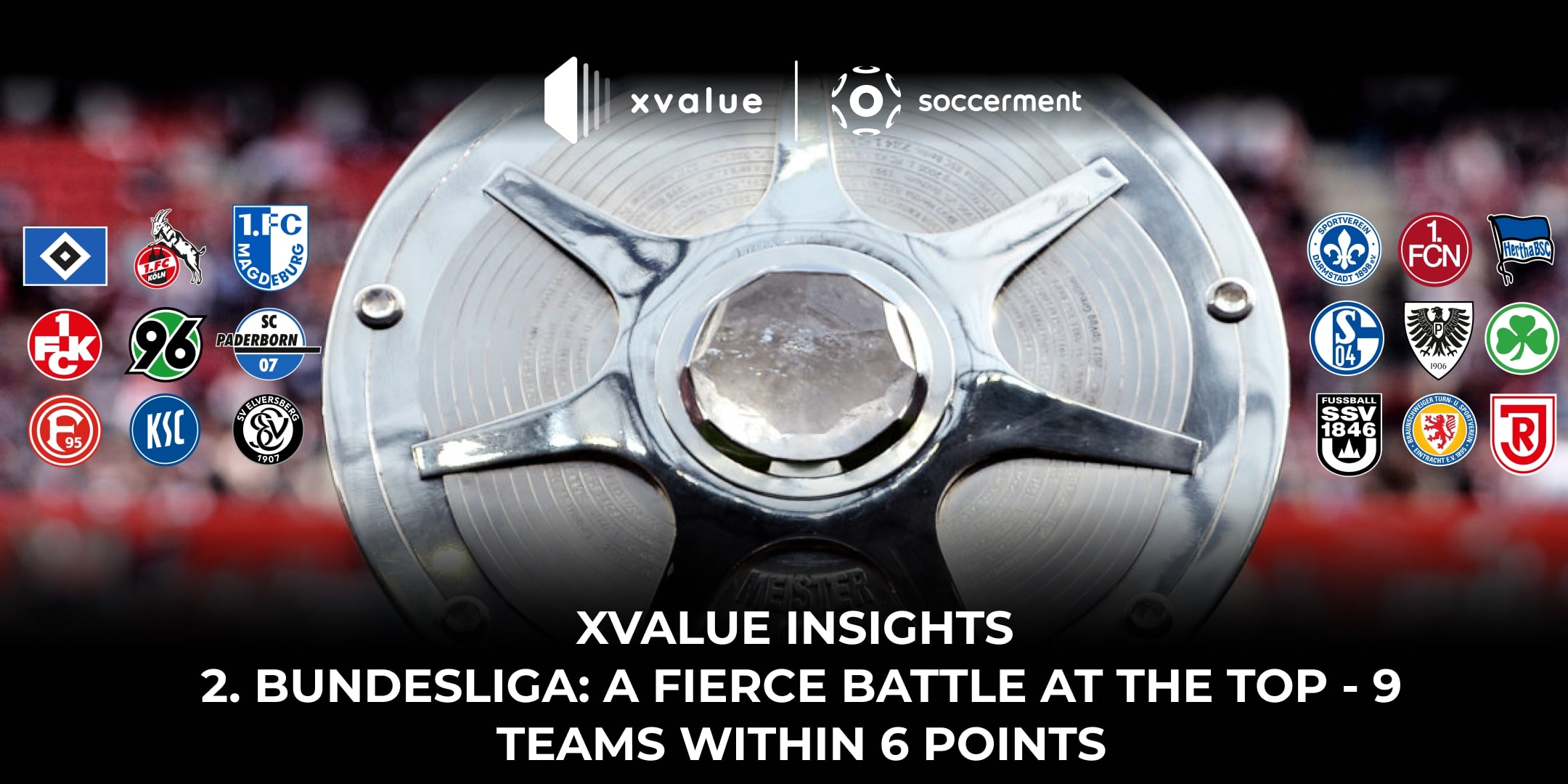
Key Insights:
- After 19 games, the top 9 teams in the 2. Bundesliga are separated by just 6 points.
- The title race is incredibly tight, with discrepancies between actual points and expected points (xPoints) highlighting over- and underperformance.
- The league is among the top five in Europe for U21 player utilization and has one of the lowest average squad ages.
- Detailed analysis of offensive, defensive, and pressing metrics provides insights into team strategies and playing styles.
- Four standout individual players are analyzed based on their statistical performance and impact on their teams.
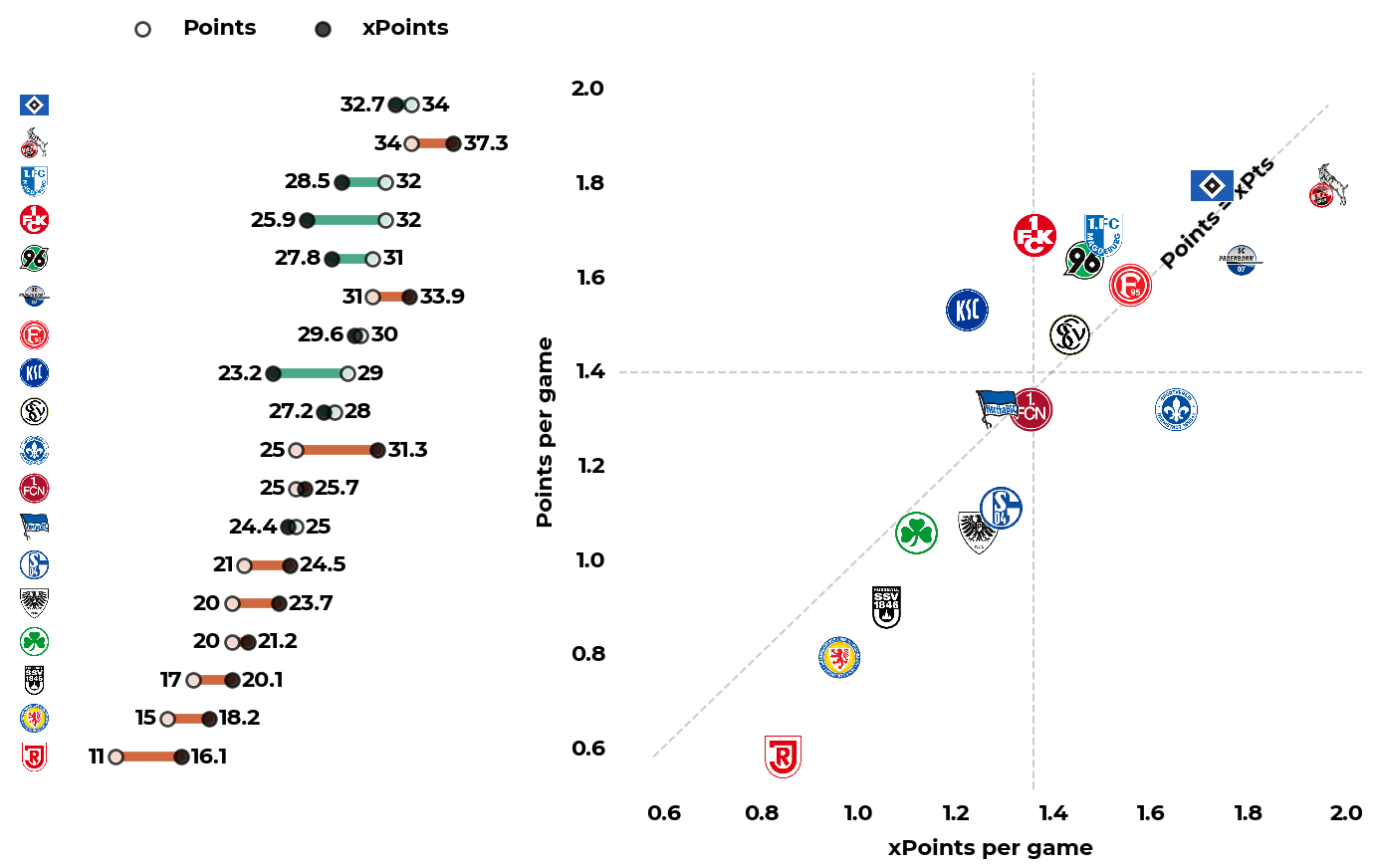
9 Teams, 6 Points: An Unprecedented Title Race
The 2. Bundesliga has become one of the most thrilling leagues in Europe this season, with an intense title race. After 19 games, no fewer than nine teams are separated by just six points at the top of the table.
As shown in the image below, Hamburg currently lead the table, tied on 34 points with FC Köln. However, xPoints suggest Köln should be first with 37 points, while Hamburg should be third with 32. The competition remains fierce, and small margins could make all the difference in the coming weeks.
Magdeburg and Kaiserslautern share third place with 32 points each, but both teams are overperforming based on their xPoints, as Magdeburg would rank sixth and Kaiserslautern ninth based on the xG created and conceded in their matches.
Hannover 96 and Paderborn 04 are tied for fifth place with 31 points. Interestingly, Paderborn has underperformed in relation to their xPoints (33), which would place them second in an expected ranking.
Further down, Fortuna Düsseldorf sits in seventh place with 30 points, followed by Karlsruher (29 points) and SV 07 Elversberg (28 points). Karlsruher have the largest overperformance in the league, as they would be 14th based on their xPoints (23).
Youth Development: A League Focused on Young Talent
Comparing the 2. Bundesliga to other European leagues, it stands out as the fifth-highest in terms of U21 player utilization and boasts one of the lowest average squad ages.
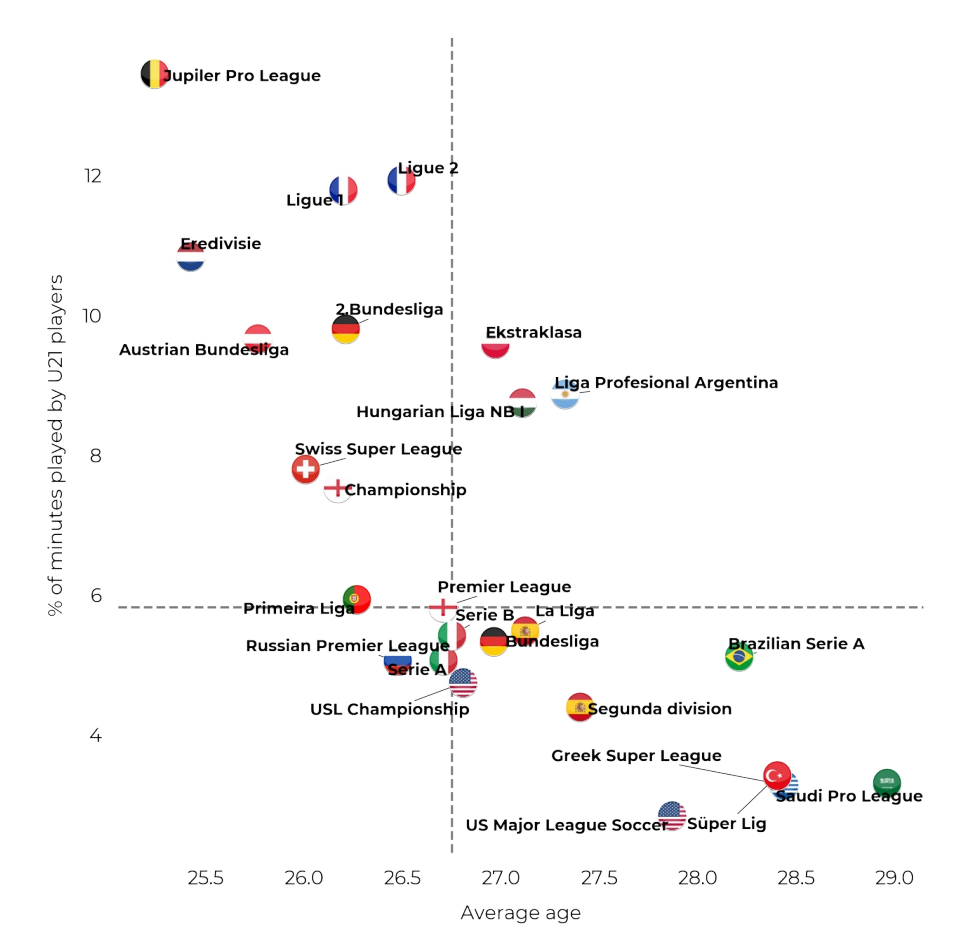
Within the league, Paderborn 07 leads the way in U21 player usage and ranks second in average squad age. Despite their young squad, they are sixth in the standings and only three points off the top.
On the opposite end, Hannover 96 has the highest average squad age, yet they are still competing at the top, currently in fifth place.
Among the nine teams analyzed, only three—Paderborn 07, Köln, and SV 07 Elversberg—fall into the quadrant of teams that combine a high U21 utilization rate with a low average squad age.
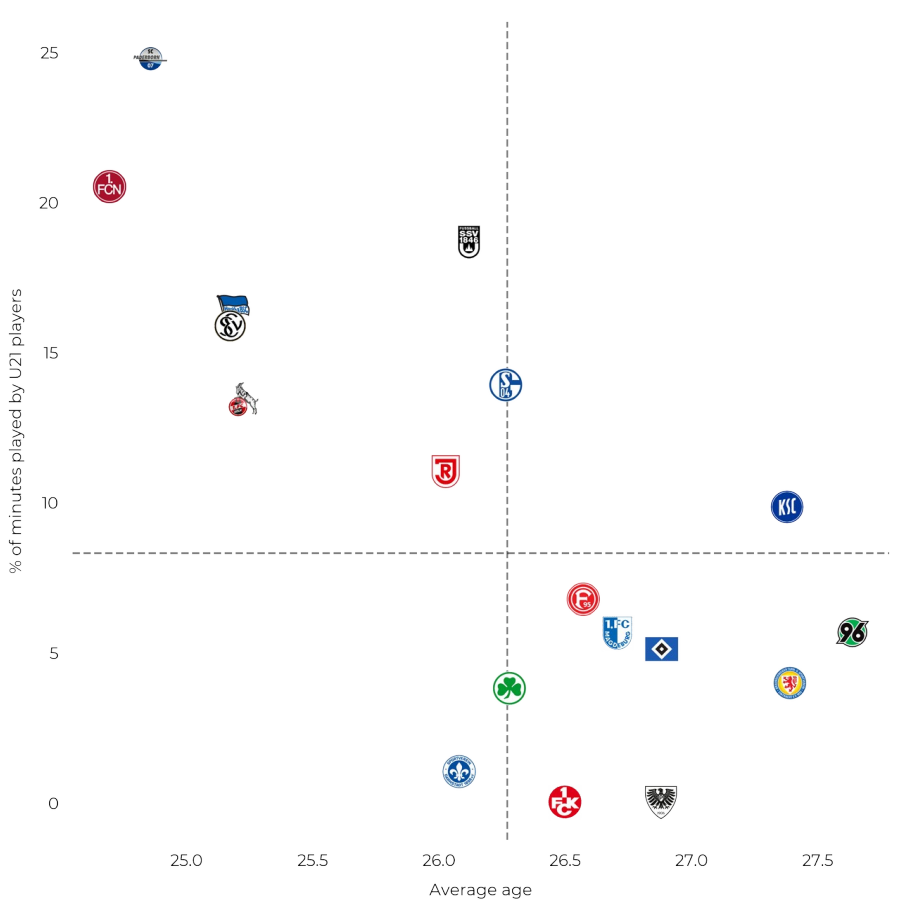
Attacking Metrics: Hamburg’s Dominance in xG
Analyzing offensive metrics through the scatter plot of non-penalty Expected Goals (npxG) per 90 minutes and npxG per shot, Hamburg emerges as the most dominant team. They lead both metrics, reinforcing their attacking efficiency.
Köln follows closely in terms of total npxG per 90 but lag in npxG per shot, ranking eighth. This suggests that while Köln create a high volume of chances, their shot quality is often suboptimal.
Hamburg also lead the league in xG generated from counterattacks (0.24 per 90) and Goal Conversion (%) at 15.93%, highlighting their ability to create and capitalize on scoring opportunities.
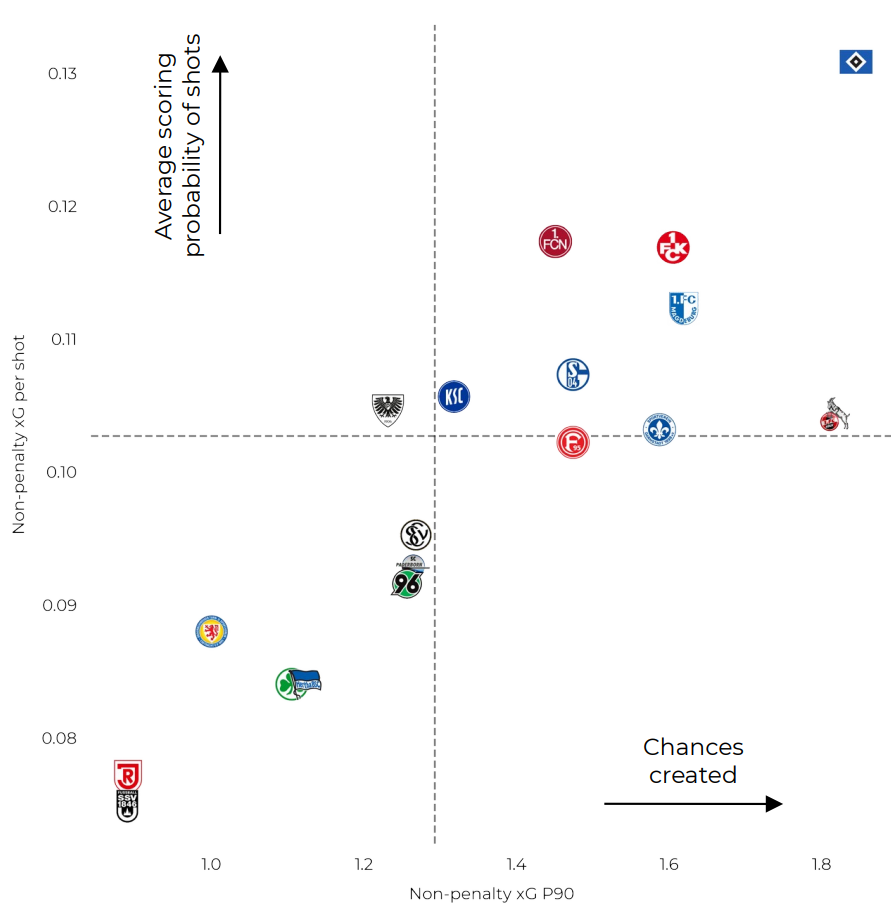
Possession & Playing Styles
Looking at possession-based metrics, Köln rank first in Field Tilt (% of possession in the opponent’s half) with 63.98%, while Magdeburg lead in overall possession with 59%.
Despite ranking fifth in overall possession, Köln’s high Field Tilt (along with leading in touches in the opposition box at 31.7 per 90) shows they prioritize an aggressive, attacking-oriented possession style.
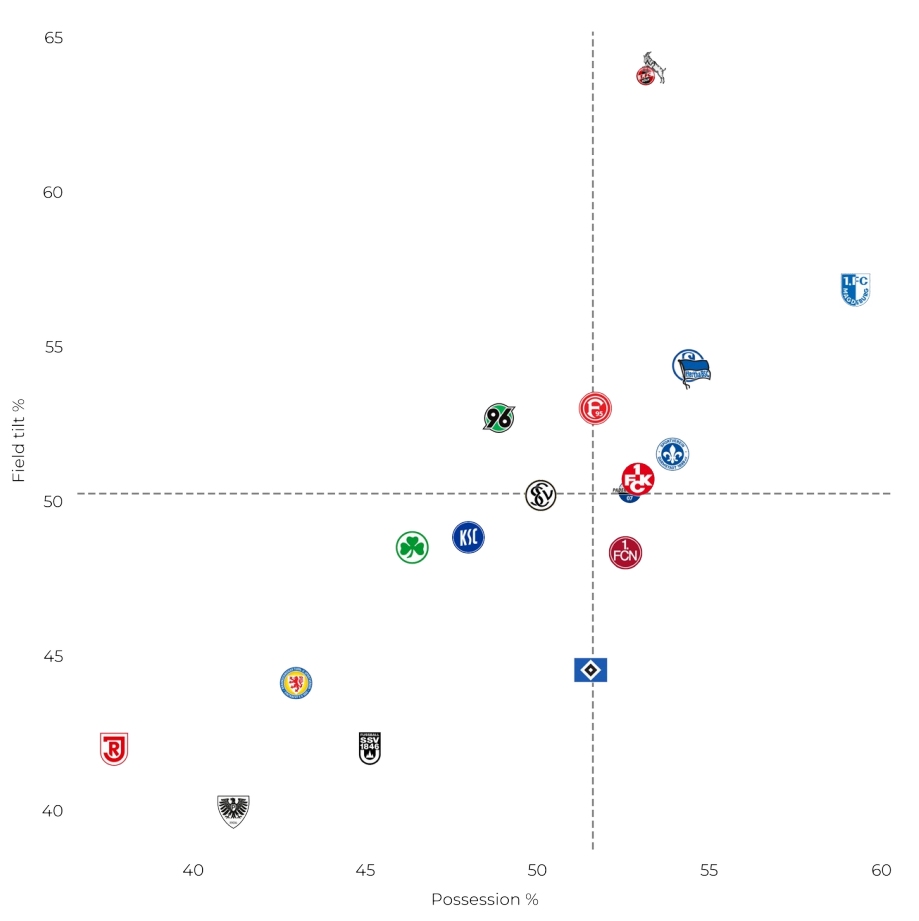
Wide Play: Crossing vs. Dribbling
Analyzing how teams utilize wide areas, Hannover 96 lead in crosses per 90 (22.72), followed by Fortuna Düsseldorf (22.11).
Interestingly, five of the top nine teams rely heavily on crosses, each averaging over 20 per 90 minutes. These teams are Hannover 96, Fortuna Düsseldorf, Paderborn 07, Karlsruher, and Köln.
Conversely, Magdeburg and SV 07 Elversberg rely more on dribbling, with both averaging around 17 dribbles per 90.
Köln also lead the league in cutbacks per 90 (1.58), demonstrating their emphasis on low-driven passes from wide areas.
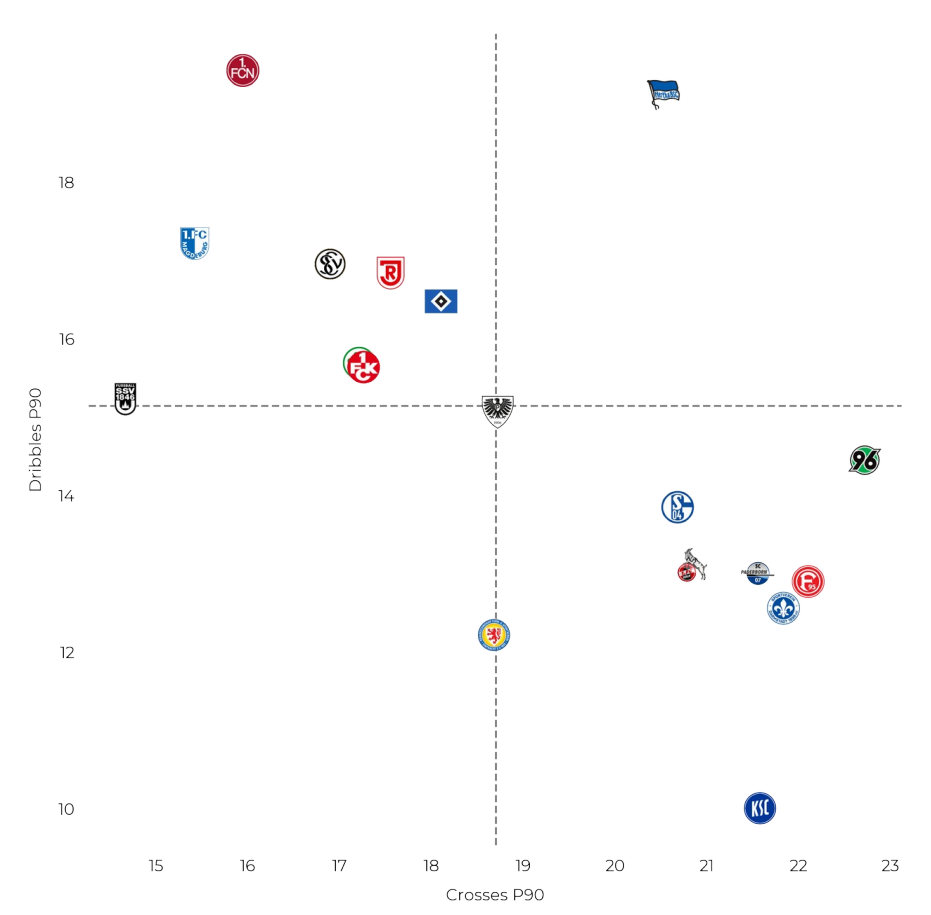
Defensive Strength & Pressing Styles
Paderborn 07 emerge as the league’s best defensive team in terms of npxGA per 90 and xGA per shot. They also rank second for xG conceded from counter attacks per 90 (0.07), showing their compact and well-structured defense.
Kaiserslautern, on the other hand, rank poorly in defensive metrics, conceding the highest xGA per shot (0.13) and ranking second-worst for total xGA per 90 (1.70).
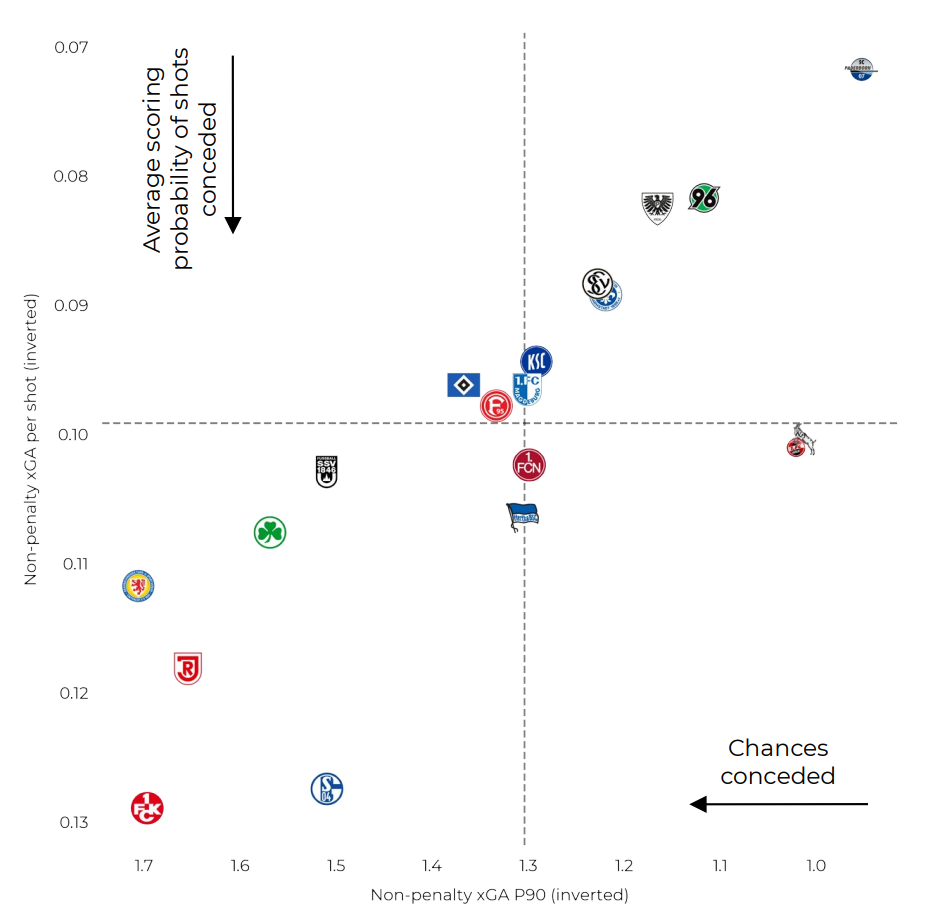
Pressing & High Turnovers
Hannover 96 and Magdeburg lead in pressing effectiveness, ranking first and second, respectively, in BDP (Buildup Disruption Percentage) and PPDA (Passes per Defensive Action).
Köln follow closely, ranking third in both metrics and leading the league for fewest touches conceded in the penalty area per 90 (17.8), illustrating their high defensive line and aggressive pressing system.
At the other end, Fortuna Düsseldorf struggle in pressing efficiency, ranking last in PPDA (16.13) and second-last in BDP (-2.52). However, their goalkeeper has been a standout performer, ranking second in Save Ratio (74.53%).
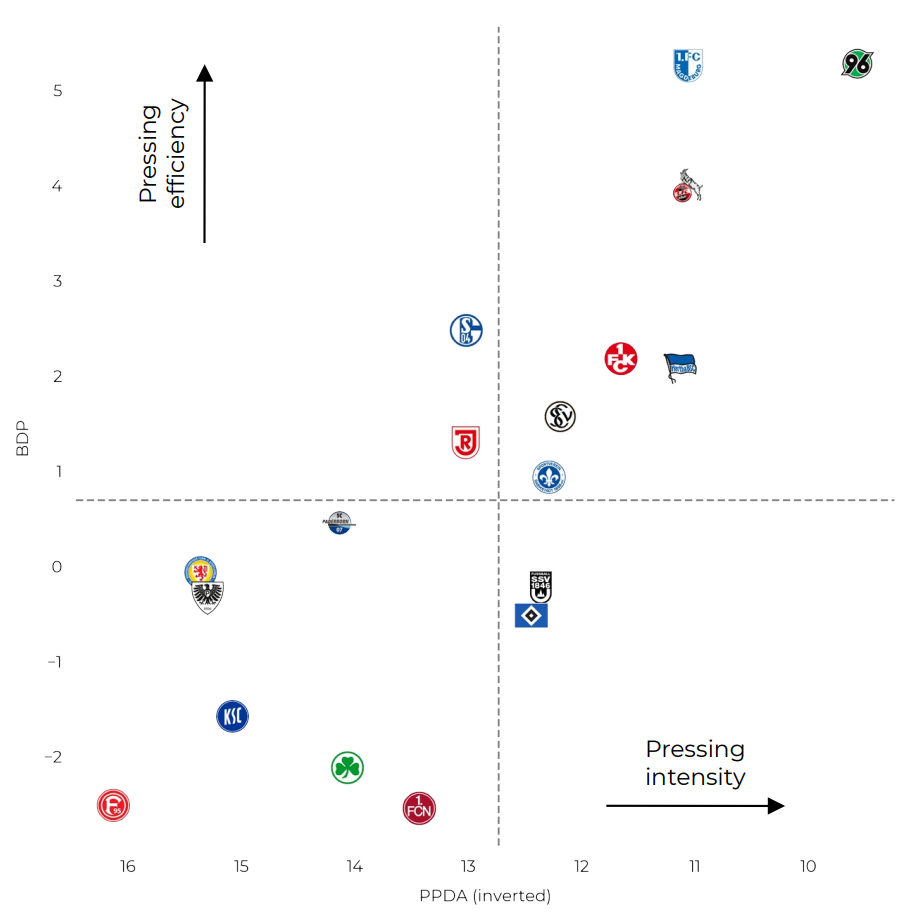
Counter-Pressing Effectiveness: GPI and GPE Analysis
Continuing our team analysis, the last scatter plot we examine provides an overview of counter-pressing intensity and effectiveness, focusing on the GPI and GPE metrics. Once again, Hannover 96 and Koln stand out as two of the most efficient teams in this phase of play. Hannover 96 rank second in GPI with a value of 48.68% and first in GPE at 30.22%, confirming their highly aggressive approach to immediate ball recovery. Koln, on the other hand, lead the GPI ranking with 49.01%, emphasizing their high and immediate pressing strategy, and rank third in GPE with 28.26%.
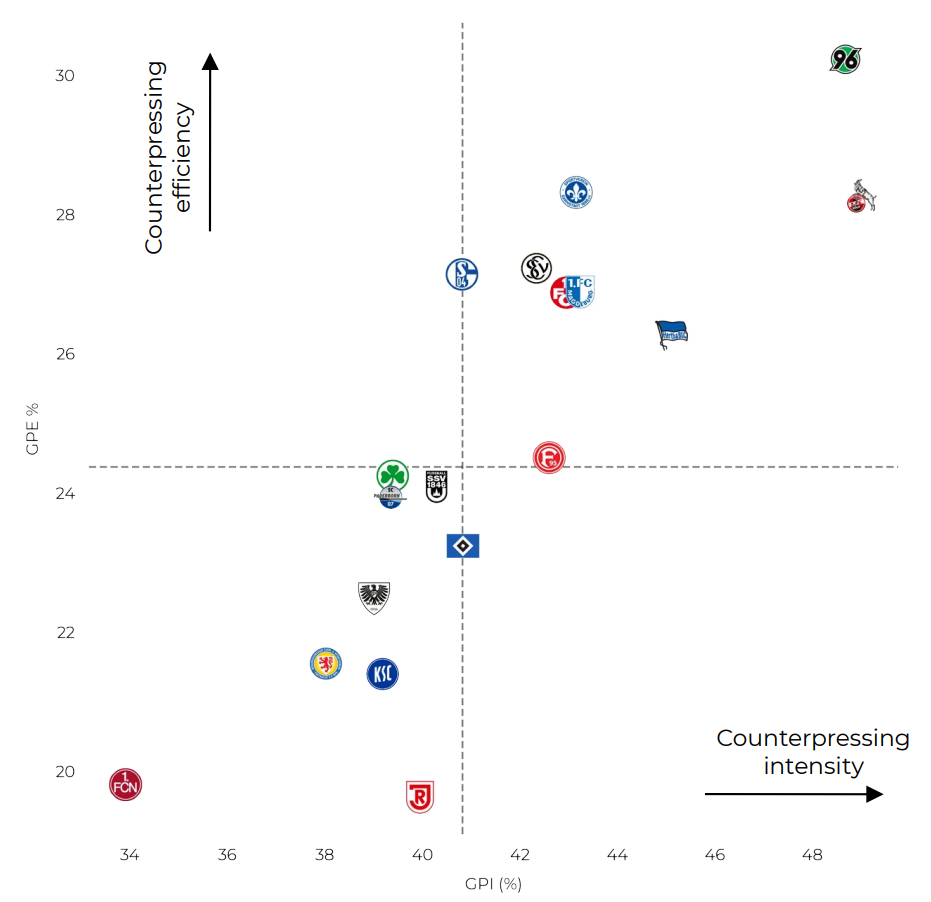
Standout Individual Performances
After analyzing team performances, let’s now shift our focus to some of the most interesting individual players in the league—those standing out across various metrics, from offensive to defensive contributions.
Robert Glatzel: The Reliable All-Round Finisher
One of the most intriguing profiles is Robert Glatzel, Hamburg’s striker, who falls into the All-round finisher cluster. Born in 1994, he is an experienced forward now in his fourth season with Hamburg. His goal-scoring consistency over recent seasons has been remarkable, netting 22, 19, and 22 goals, while this season he has already scored 7 goals in just 6 appearances. Looking at his radar, we can see that he ranks first for average non-penalty xG per shot (0.27) and second for total non-penalty xG per 90 minutes (0.96). Furthermore, he stands out in terms of touches in the opponent’s penalty area, xOVA per 90 minutes, and xA received, highlighting his pivotal role in Hamburg’s attacking setup.
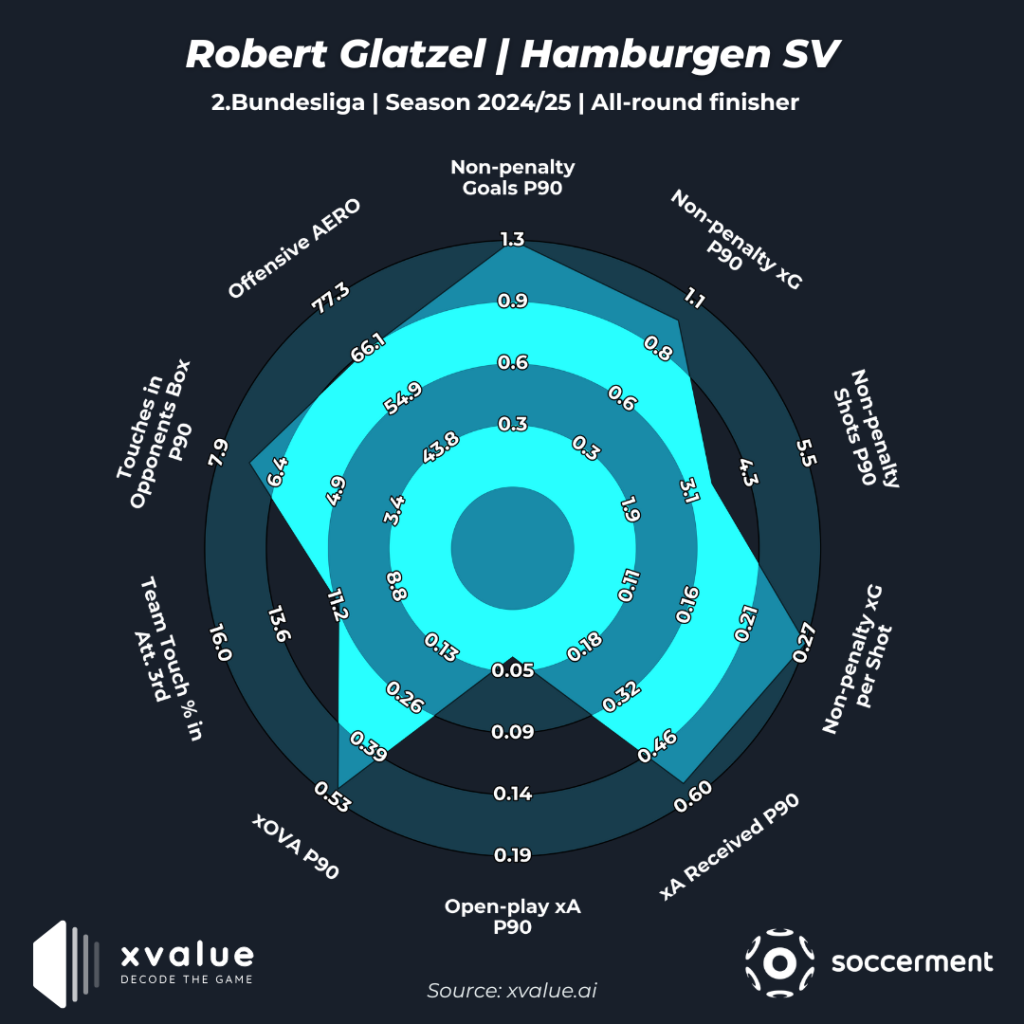
Tatsuya Ito: The Creative Playmaker
Another emerging player is Tatsuya Ito, an attacking winger from Magdeburg, who was recently acquired by Kawasaki Frontale in Japan. During his time at Magdeburg, Ito was a standout performer, leading the league by a significant margin in xT generated from both passing and carrying. His radar shows that he produces 0.26 xT per 90 minutes from passing and 0.11 xT from carrying, confirming his crucial role in Magdeburg’s offensive play. Additionally, he excels in the percentage of team touches in the final third, open-play xA per 90 minutes, and non-penalty shots per 90 minutes.
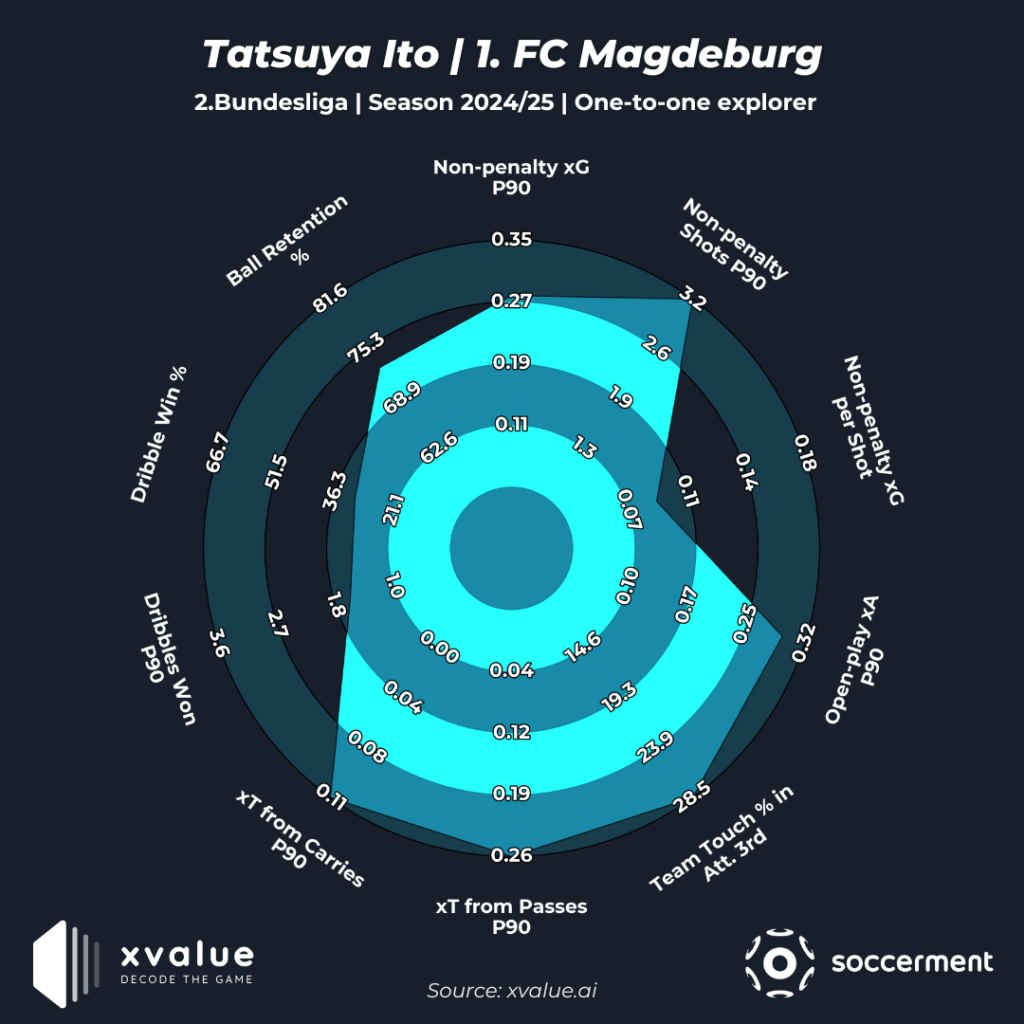
Paul Seguin: The Buildup Director
Moving to the midfield, one of the key players in this league is Paul Seguin, Schalke 04’s central midfielder, born in 1995 and categorized within the Buildup Director player function. His radar clearly highlights his importance in Schalke’s buildup play, as he records 4.9 progressive passes and 1.9 progressive carries per 90 minutes. His centrality in Schalke’s system is further reinforced by the fact that he leads the league among midfielders in terms of percentage of team touches, boasting an impressive 16.6%.
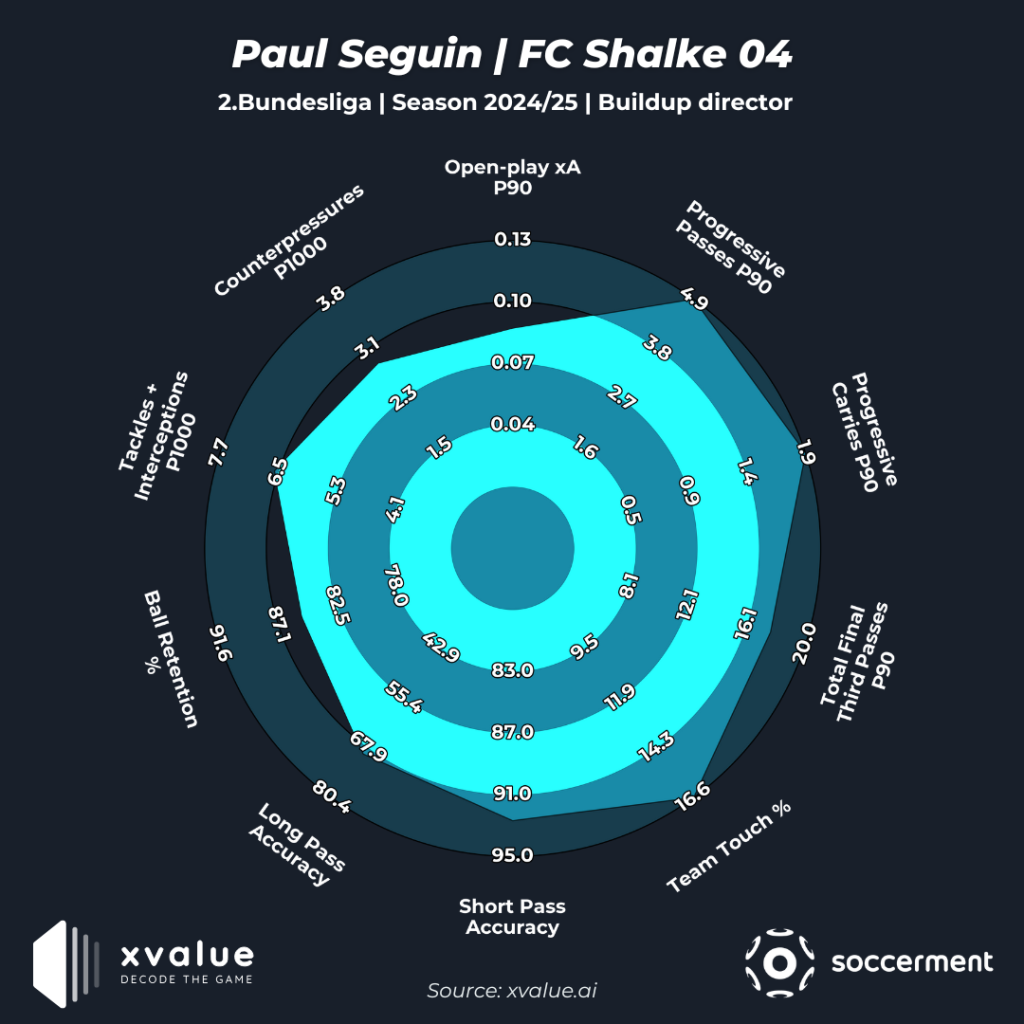
Kevin Sessa: The Defensive Anchor
We conclude the analysis with Kevin Sessa, Hertha Berlin’s midfielder, born in 2000 and also classified as a Buildup Director. Comparing his radar to other midfielders in the league, it is immediately evident that he is the top performer in counter-pressing defensive actions, with 4.1 per 1000 opponent touches. This metric underscores his crucial role in negative transitions, where he excels at immediately recovering possession and disrupting opponents’ counter attacks.
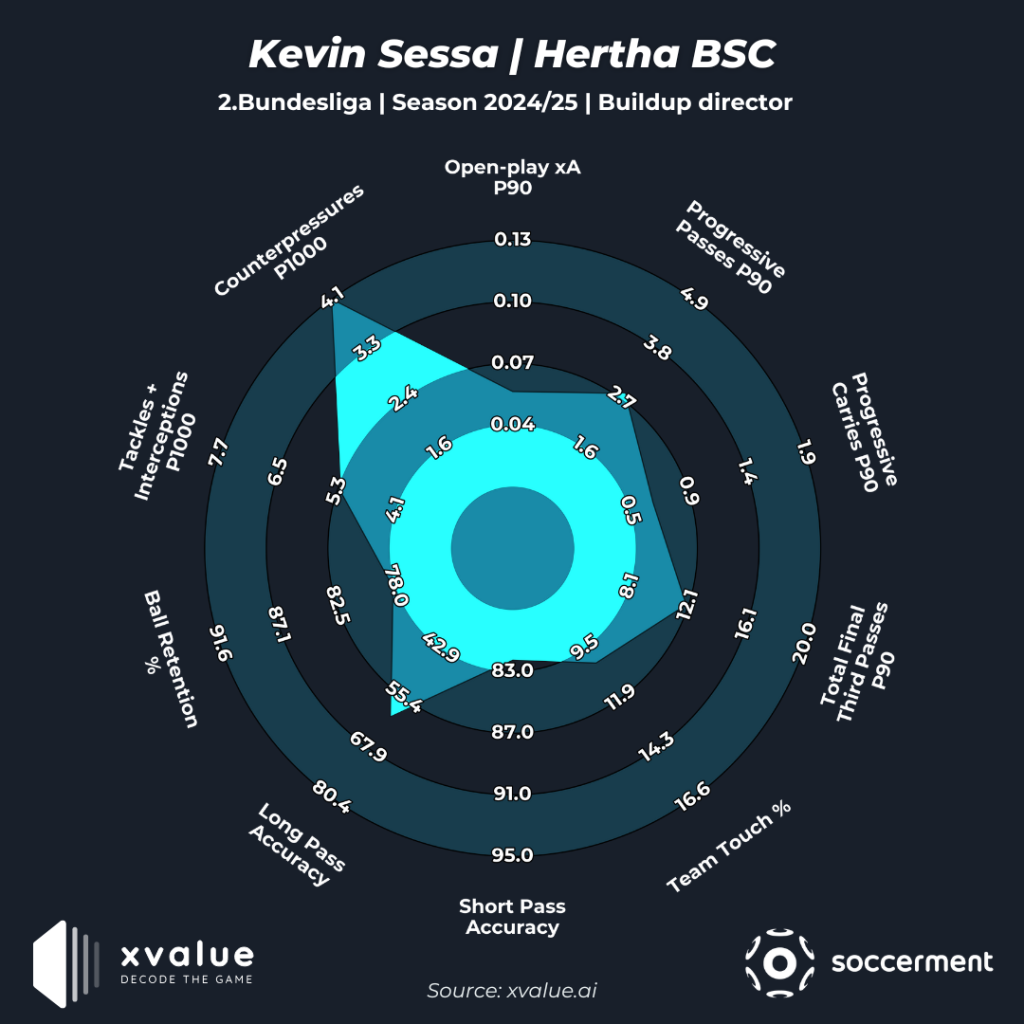
Conclusion
With the league shaping up to be a fiercely contested battle, several key takeaways emerge from our analysis:
- Hannover 96 and Koln lead in counter-pressing effectiveness, showcasing high-intensity defensive transitions.
- Robert Glatzel remains a dominant striker, consistently producing high xG numbers and playing a key role in Hamburg’s attack.
- Tatsuya Ito stood out as one of the best creators in the league before his move to Japan, excelling in xT from both passing and carrying.
- Paul Seguin is a midfield metronome for Schalke 04, leading in progressive actions and team involvement.
- Kevin Sessa is a defensive force in midfield, excelling in counter-pressing actions and disrupting opposition attacks.
As the season progresses, the battle for promotion remains wide open, with multiple teams in contention. Which team do you think has the edge in this nine-team fight for the top spots? Let us know your thoughts!
Thanks!
Learn more about xvalue, the go-to analytics platform for scouting and match analysis 👉🏻 xvalue.ai
Stay tuned and don’t miss out on the latest updates and insights from Soccerment!

Leave a Reply